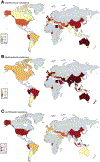Prevalence of Antibiotic Resistance in Helicobacter pylori: A Systematic Review and Meta-analysis in World Health Organization Regions
- PMID: 29990487
- PMCID: PMC6905086
- DOI: 10.1053/j.gastro.2018.07.007
Prevalence of Antibiotic Resistance in Helicobacter pylori: A Systematic Review and Meta-analysis in World Health Organization Regions
Abstract
Background & aims: In 2017, the World Health Organization (WHO) designated clarithromycin-resistant Helicobacter pylori a high priority for antibiotic research and development. However, there are no clear data on the global distribution of resistance or its clinical effects. We performed a systematic review and meta-analysis to assess the distribution of H pylori resistance to commonly used antibiotics and to measure the association between antibiotic resistance and treatment failure.
Methods: We searched publication databases for studies that assessed rates of H pylori resistance to clarithromycin, metronidazole, levofloxacin, amoxicillin, or tetracycline. Pooled estimates of primary and secondary resistance and 95% confidence intervals (CIs) were grouped by WHO region. The association between antibiotic resistance and treatment failure was measured by extracting data on treatment efficacy in patients with resistant and susceptible isolates and pooling odds ratios with 95% CIs.
Results: We identified 178 studies, comprising 66,142 isolates from 65 countries. Primary and secondary resistance rates to clarithromycin, metronidazole, and levofloxacin were ≥15% in all WHO regions, except primary clarithromycin resistance in the Americas (10%; 95% CI, 4%-16%) and South-East Asia region (10%; 95% CI, 5%-16%) and primary levofloxacin resistance in the European region (11%; 95% CI, 9%-13%). There was considerable heterogeneity (I2 > 75%) among all analyses-this might have resulted from the grouping of resistance rates by country. Increasing antibiotic resistance was observed in most WHO regions. Resistance to clarithromycin was significantly associated with failure of clarithromycin-containing regimens (odds ratio, 6.97; 95% CI, 5.23-9.28; P < .001).
Conclusions: Resistance of H pylori to antibiotics has reached alarming levels worldwide, which has a great effect on efficacy of treatment. Local surveillance networks are required to select appropriate eradication regimens for each region.
Keywords: Bacterial Infection; Drug; Epidemiology; Prevalence.
Copyright © 2018 AGA Institute. Published by Elsevier Inc. All rights reserved.
Conflict of interest statement
Conflicts of interest
The remaining author discloses no conflicts.
Figures
Comment in
-
Antibiotic Resistance Is the Key Element in Treatment of Helicobacter pylori Infection.Gastroenterology. 2018 Nov;155(5):1300-1302. doi: 10.1053/j.gastro.2018.10.012. Epub 2018 Oct 8. Gastroenterology. 2018. PMID: 30308190 No abstract available.
References
-
- Hooi JKY, Lai WJ, Ng WK, et al. Global prevalence of Helicobacter pylori infection: systematic review and meta-analysis. Gastroenterology 2017;153:420–429. - PubMed
-
- Pounder RE, Ng D. The prevalence of Helicobacter pylori infection in different countries. Aliment Pharmacol Ther 1995;9(Suppl 2):33–39. - PubMed
-
- Malfertheiner P, Megraud F, O’Morain CA, et al. Management of Helicobacter pylori infection-the Maastricht V/Florence Consensus Report. Gut 2017;66:6–30. - PubMed
-
- Torre LA, Bray F, Siegel RL, et al. Global cancer statistics, 2012. CA Cancer J Clin 2015;65:87–108. - PubMed
Publication types
MeSH terms
Grants and funding
LinkOut - more resources
Full Text Sources
Other Literature Sources
Medical



